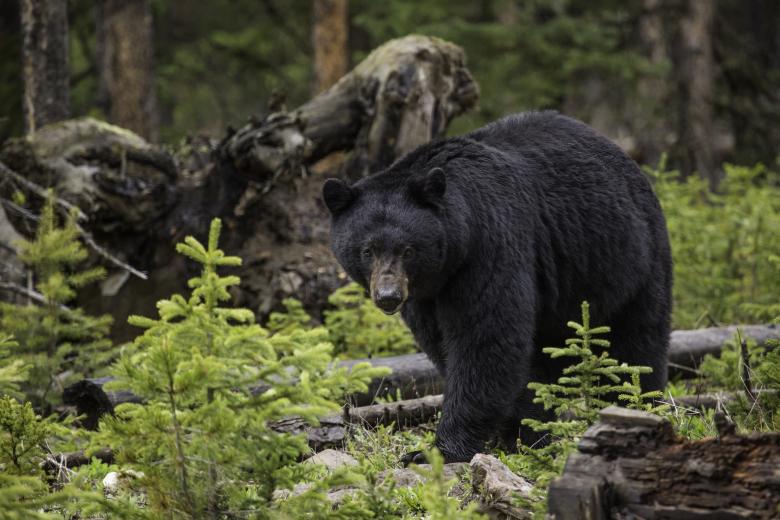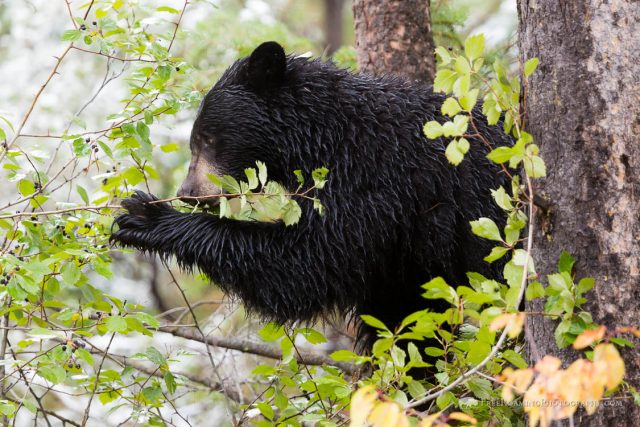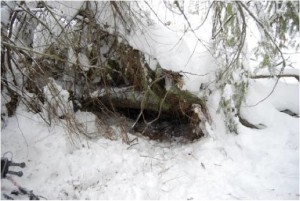
Black Bear Biology & Behavior
American black bears are the most numerous of all the bear species of the world, occurring in habitats across North America with a population estimate of around 25,000 widely distributed throughout Washington State. Not only are they found exclusively in North America, black bears are the only living bear species to have evolved here.
Ecological Roles of Black Bears
Black bears reside in temperate rainforests, dry eastern slope woodlands, neighborhood greenbelts, and anywhere they can find forest cover and plentiful food from sea level to 10,000 foot elevations. Their habitat is characterized by thick forested areas and understory vegetation with an abundant supply of fruit and nut-bearing trees and shrubs. Black bears play an important role in forest ecosystems as seed dispersers and nutrient providers. Berry seeds pass through the bear unbroken and are able to germinate. Not only that, but the seeds come with their own pile of fresh manure as fertilizer!
Short, curved claws make black bears excellent tree climbers. In contrast, grizzly bear claws are much longer, more blunt and are used primarily for excavating food from their preferred open country and high mountain meadow habitats. Grizzly bears, although not adapted primarily for tree-climbing, can still climb any tree you can climb!
Their claws are also well-suited for tearing apart snags and logs and digging up forest duff where they encounter food such as insects and their larvae, small rodents and amphibians. This foraging behavior helps the decaying process in the forest and the return of nutrients to the soil. They are primarily opportunistic omnivores, travelling about their territories, up to 100 square miles, in response to the seasonal availability of food.
Black bears have excellent memories and their sense of smell is unparalleled – more than seven times greater than a dog. They spend their days learning about particular foods and developing their memory about where they can be encountered. Some individual bears have been known to so finely tune their knowledge of where garbage cans are located, that they actually learn the days and routes used by garbage haulers.

A black bear balances in a tree while reaching for berries from a hawthorne berry tree in Grand Teton National Park, Wyoming.
In the temperate rainforests found in the coastal watersheds of the Pacific Northwest, migrating salmon comprise a substantial part of the black bear’s diet. In fact, black bears provide essential ecosystem services in these watersheds. Foraging bears transfer large numbers of salmon (eight bears transferred 3100 salmon in one study) from the stream into the riparian zone, leaving the remnants of the decomposing carcasses fixing much needed nitrogen into the soils of the Northwest Coast. The nutrients provided by the salmon are taken up by the root systems of giant coniferous trees, such as Sitka Spruce, and researchers have discovered that the marine-derived nitrogen from salmon contributes substantially to the size, health and vigor of these trees and the surrounding forest community.
During the fall and prior to hibernation all bears enter a physiological phase called hyperphagia, a term that literally means “excessive eating.” Foraging up to twenty hours a day during the autumn months, black bears increase their body weight by thirty-five percent in preparation for winter hibernation. While black bears prefer their native foods, easy-to-access anthropogenic (human-provided) food sources are extremely tempting. Accessing garbage requires little energy expenditure with the payoff being concentrated, nutrient rich, calorie-packed food.
Black Bear Dens and Hibernation
Do black bears hibernate? The short answer is yes. Although there has been past scientific debate about whether or not one of the world’s most famous “hibernator” actually does so, black bears are able to survive severe weather and annual winter food shortages by denning and hibernating during those winter months.
While in hibernation, black bear heart rates typically drop very substantially from 40 – 50 beats per minute down to 8 beats per minute, and there are other beneficial physiological changes which help them maintain this prolonged state of torpor, but their body temperatures do not drop significantly. Unlike other hibernators, black bears are dormant, but don’t need to wait to bring up body temperatures – and thus can awaken and arouse quickly. This condition allows bears to defend themselves and their cubs more effectively should an outside predator disturb them in the den.
Bears hibernate for varying lengths of time depending on where they live and will even occasionally emerge from their dens for a period during the winter. In warmer climates a bear might spend just a few weeks denning, or sometimes not den at all. In Washington and Idaho, black bears den for an average of around 5 months each winter.
Black bears most often choose to den under large boulders, simple depressions under brush, in tree cavities above ground or at the base of a tree, under logs, or even buildings. Compared to grizzly bears, black bears tend to den at lower elevations and in less steep areas than their grizzly bear cousins.
Bears burn fat while in the den and produce usable by-products such as water. The kidneys release less waste than during active times of the year, and the small amount that is created is reabsorbed through the bladder wall. The urine is essentially recycled internally and then is converted to carbon dioxide, water and ammonia. Bears do not defecate while in hibernation.
Black Bear Reproduction and Maturation
The home range of a female black bear is typically 2.5 to 10 square miles (6.4-25.9 square kilometers). Male black bears range over much larger areas and home ranges are 10 to 59 square miles (26-152 square kilometers). Female black bears generally will not share their territory with other females, but the ranges of several males may overlap with hers.
Black bear females do not reproduce until they are three to five years old but some may be as old as seven when they first produce young. Females normally breed every other year and have an average of two cubs, but can have one to five. Cub mortality is high, with an average of 50 percent dying in their first year due to natural causes. The female has 6 nipples, but often only two primary teats produce milk that is exceptionally high in fat, hence the cubs’ rapid growth.
Females conceive during the summer (mid June to July in Washington) and overall gestation time is 7 to 7 1/2 months. However, impregnated females go through a process called delayed implantation so actual embryo development does not begin until November or December. Cubs are born two months later, in January or February weighing just 225 to 330 grams (1/2 to 3/4 pounds) and measuring about 8 inches long. The cubs are blind and deaf, have poorly developed hindquarters, and are covered with fine down-like hair. They suckle frequently from the female in the den and emerge with her in the spring. They remain with the female for 16 to 18 months during which time she teaches them everything they need to know to survive. Female black bears do not mate while rearing young, so may only produce six litters in her lifetime.
The average lifespan of a black bear can be up to 18 years, and the oldest documented wild bear lived to 31. During their lives black bears can suffer from arthritis, cavities, fractures from falls, broken and worn teeth, bites from other animals and gun shots.
Black Bear Communication
Black bears emit a variety of vocalizations to communicate with other bears and other species. Along with vocalizations, bears use posturing to communicate dominance or subordination, and to express attitudes. In order to establish dominance, male black bears will often claw trees, with the highest marks on the tree associated with the most dominant male.
Two often-misinterpreted forms of black bear communication that can put a hiker on edge are bluff charges and a bear standing upright on its hind legs. Bluff charges are far more common than actual attacks, and are used to scare off a potential threat. They are generally broken off a few feet away, sometimes accompanied by stamping on the ground. A bear standing on its hind legs is simply trying to get a better look with its mediocre vision.
Threats to Black Bears
American black bears adapt well to human development, and their global population is estimated to be twice that of all other species of bears combined. While they are not threatened at this time, individual bears often come into conflict with humans. Because of their adaptability, they can live in close proximity to human development. Particularly in years when the local berry crop fails, they will frequent municipal garbage dumps and household garbage cans looking for food. Once they become habituated or begin to be seen as a threat to people or pets, they can be relocated or even killed by wildlife authorities.
As more housing developments and roads are built on the fringes of the urban areas in western Washington, black bears are losing habitat, and opportunities for them to pursue their natural food sources are becoming even more limited. This is resulting in increased interactions between black bears and humans. As climate change shifts the distribution of their food sources, conflicts are likely to increase as they seek out new, suitable habitat. A large network of interconnected, wild lands would reduce the risk of conflict.


